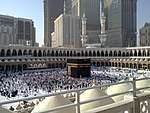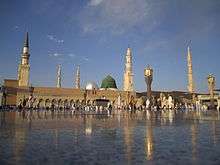Meccan boycott of the Hashemites
The Meccan boycott of the Hashemites was a public boycott against the clan of Banu Hashim, declared in 616 (7th year of Prophethood) by the leaders of Banu Makhzum and Banu Abd-Shams, two important clans of Quraysh. According to tradition, the boycott was carried out in order to put pressure on Banu Hashim to withdraw its protection from Muhammad.[1][2]
- This is a sub-article to Muhammad before Medina
The terms imposed on Banu Hashim, as reported by Ibn Ishaq, were "that no one should marry their women nor give women for them to marry; and that no one would trade with them, and when they agreed on that they wrote it in a deed."[3] The boycott lasted for three years but eventually collapsed mainly because it was not achieving its purpose; the boycott had caused extreme privation and the sympathizers within the Quraysh finally united to annul the agreement.[2][4]
Overview
It became a source of great troubles for the Muslims. They were forced to do their second migration to an area called Shib Abi Talib or Shib Abi Hashim where they suffered hunger.[5] The boycott was ended in 619, the Year of Sorrow.
History
...The Quraysh gathered together to confer and decided to draw up a document in which they undertook not to marry women from Banu Hashim and the Banu al Muttalib, or to give them women in marriage, or to sell anything to them or buy anything from them. They drew up a written contract to that effect and solemnly pledged themselves to observe it. They then hung up the document in the interior of the Kaaba to make it even more binding upon themselves. When Quraysh did this, the Banu Hashim and the Banu al-Muttalib joined with 'Abu Talib, went with him to his valley and gathered round him there; but 'Abu Lahab 'Abd al Uzza b. 'Abd al-Muttalib left the Banu Hashim and went with the Quraysh supporting them against 'Abu Talib. This state of affairs continued for two or three years, until the two clans were exhausted, since nothing reached any of them except what was sent secretly by those of the Quraysh who wished to maintain relations with them".[6]
...These days were very hard with them and very often they had to feed on the leaves TALH or plantain" [7]
Thus, this boycott included even Hashemites that had not accepted Islam.[8]
End of boycott
According to Muslim tradition, the parchment holding the boycott declaration was found to be eaten by termites except the name of Allah.[9][10]
References
- Francis E. Peters, The Monotheists: Jews, Christians, and Muslims in Conflict and Competition, p.96
- Moojan Momen, An Introduction to Shi'i Islam: The History and Doctrines of Twelver Shiʻism, Yale University Press, p.4
- Francis E. Peters, Mecca: A Literary History of the Muslim Holy Land, Princeton University Press, 1994, ISBN 0-691-03267-X, p.54
- Daniel W. Brown,A New Introduction to Islam, Blackwell Publishing, p.76, 2004, ISBN 0-631-21604-9
- "Answering-Ansar.org :: Our 20 questions". Archived from the original on 2006-08-24. Retrieved 2006-07-25.
- Taken from Tarikh al-Tabari, Volume 6 page 81 - Muhammad at Mecca (book), translated by William Montgomery Watt & M.V. MacDonald Archived 2006-08-24 at the Wayback Machine
- taken from Siratun Nabi by Shibli Numani Vol 1 p 218, English translation by M. Tayyib Bakhsh Budayuni Archived 2006-08-24 at the Wayback Machine
- www.islam4theworld.com
- http://www.pbuh.us/prophetMuhammad.php?f=MK_Boycott
- http://aboutislam.net/shariah/prophet-muhammad/social-boycott-early-muslims-story/

